| THIS WEEK'S ARTICLES |
| Market Roundup |
| Five Charts and Four Themes for the First Half of 2021 |
| by Martin Pring |
Prices are determined by the attitude of market participants to the emerging fundamentals. Fortunately for us technicians, these attitudes move in trends, and once a trend gets underway it tends to perpetuate. Provided it is not overstretched, we can reasonably assume that that trend will continue. It's in that spirit that I offer four probable themes for at least the first half of 2021. Three are already established, while one is pointing in the direction of a change and deserves further monitoring.
1. A Bullish Stock Market
The stock market has risen impressively since last spring, but many indicators, which have an impressive long-term record, have only just turned bullish. One example is featured in Chart 1. It's the ratio between stocks and bonds, which has clearly broken out from a right-angled broadening formation. This type of formation is particularly bullish relative to its size. That's probably because it represents a reverse head-and-shoulders, but is so bullish that it does not have enough time to complete the right shoulder. The current breakout obtains credibility due to the fact that the long-term KST has just gone bullish. The green arrows show that previous reversals have been consistently followed by a higher ratio.
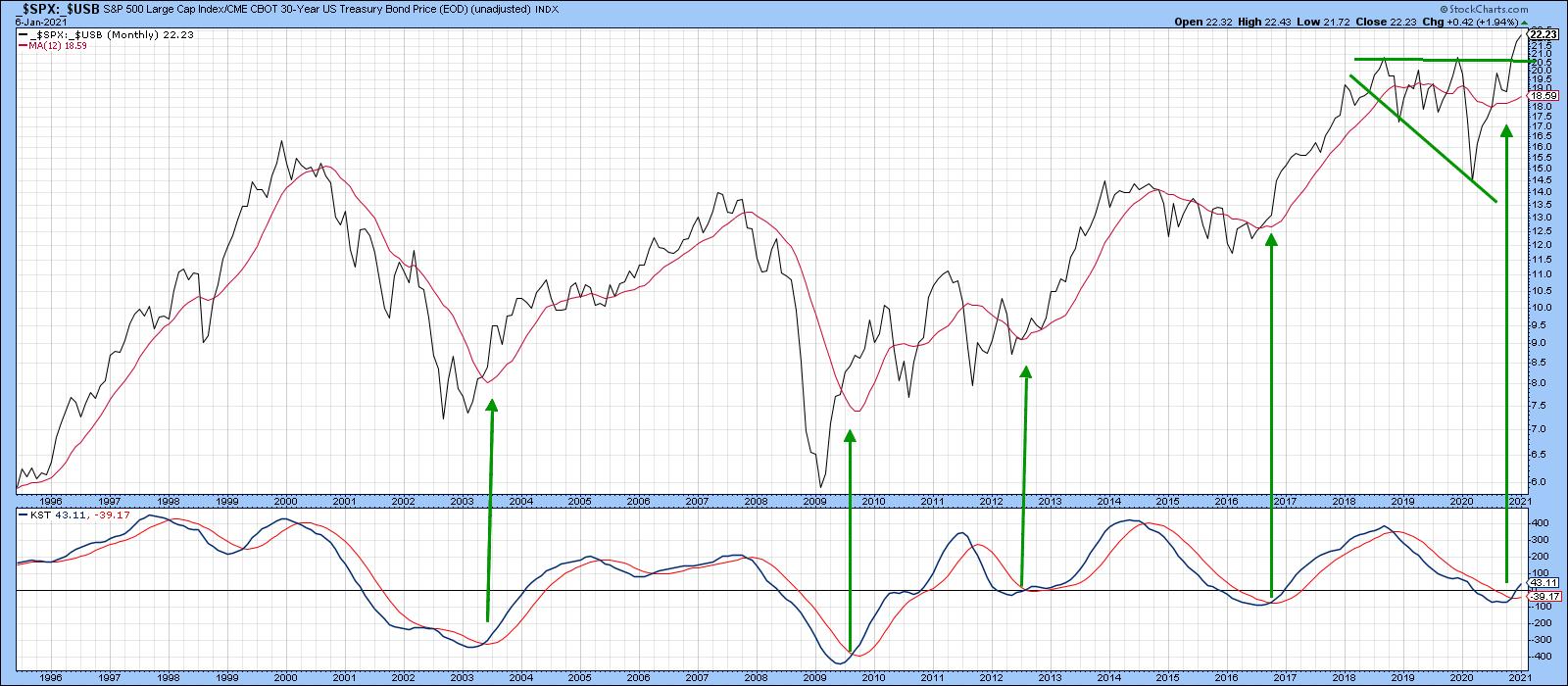 Chart 1 Chart 1
This relationship, of course, only tells us that stocks are likely to outperform bonds, not that they will rally in an absolute sense. Chart 2, on the other hand, demonstrates that these KST buy signals are consistently positive for the S&P Composite itself. Based on its currently subdued position, just above zero, it's not a stretch to say that stocks are headed higher in 2021. Now I am not going to rule out a sharp, unpredictable and unexpected corrections along the way, as some parts of the market are pretty frothy right now. However, I do believe that investors will be better served focusing on the big picture, rather than worrying about a correction of indeterminate size that may or may not develop.
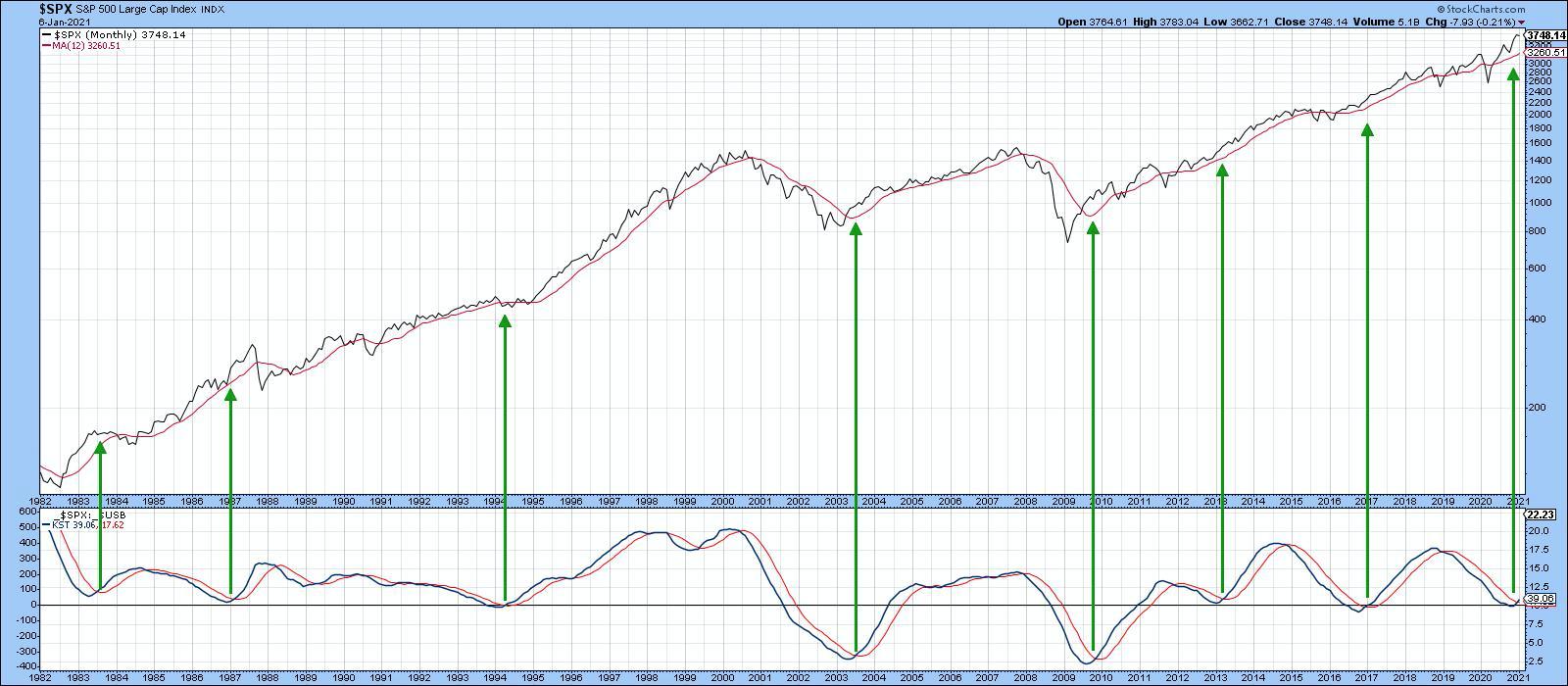 Chart 2 Chart 2
2. Bullish Commodities
Our second theme arises from the fact that the recovery has reached a point where it is consistent with a trend of rising commodities, a concept that you can read about here. Once again, there are many primary trend indicators that I could point to, but a consistent one is the ultimate inflation-deflation relationship, that being the ratio between commodities and bonds - or, more specifically, its long-term KST. Chart 3 compares it to the CRB Composite. When the KST bottoms, it signals, as far as the financial markets are concerned, that the business cycle has begun its inflationary phase. That means commodities have stopped retreating and begun to firm up. A bit later, bond yields stabilize and strengthen up up in anticipation of forthcoming inflationary pressures. As a result, upside reversals in the Commodity/Bond KST signal higher commodity prices.
The latest reversal developed a couple of months ago. Now, the price has managed to break above its 24-month MA and re-cross the (red dashed) head-and-shoulders neckline. It now stands right at its 2009-2020 secular down trendline. Since the bull market is in an early phase, that line is likely to be penetrated in 2021. Other markets likely to benefit from higher commodity prices are commodity-sensitive currencies, such as the Canadian and Aussie dollars, resource-sensitive sectors, including metals and materials, as well as commodity-sensitive emerging markets.
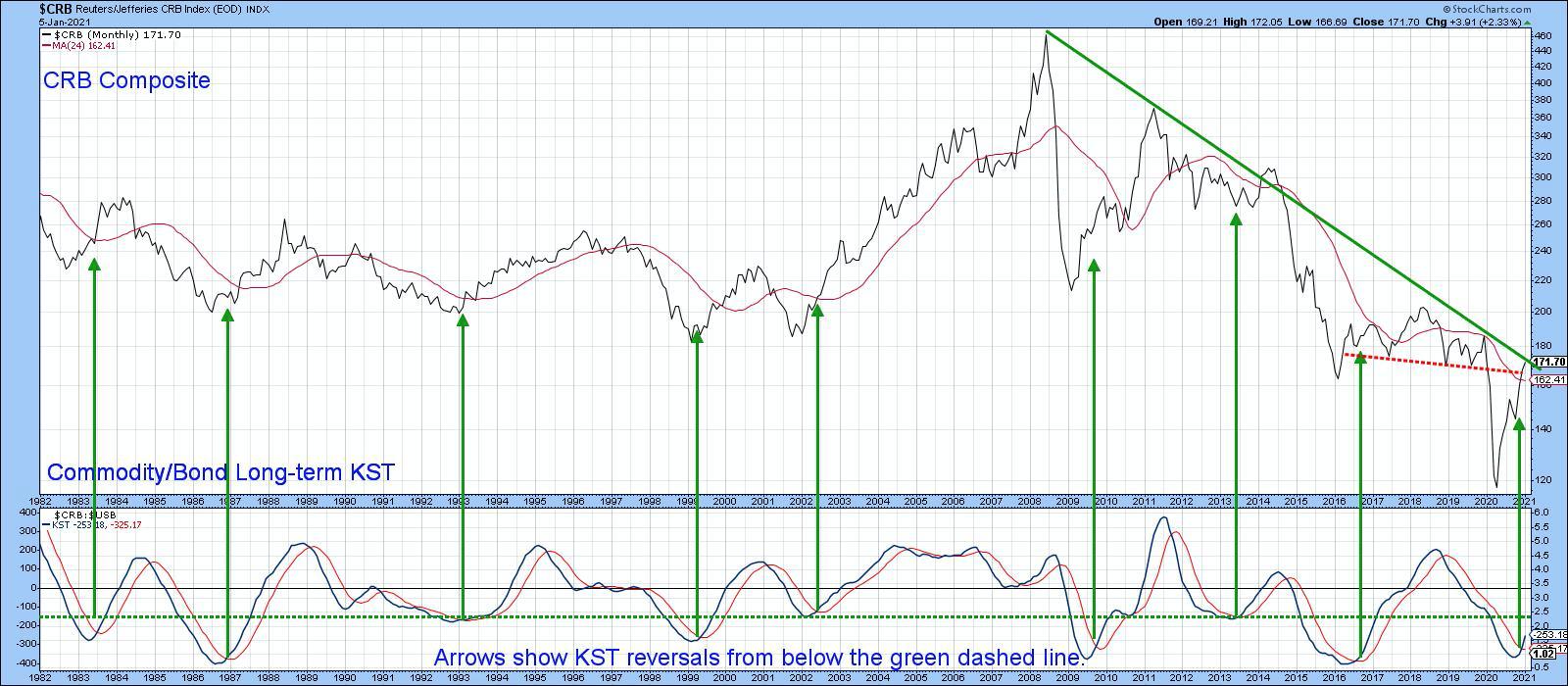 Chart 3 Chart 3
3. US versus the World
Another theme change that appears to be taking place is a reversal in the trend favoring US equities vis a vis the Dow Jones World Index. Chart 4 compares this relationship to its Special K indicator, which you can read about here. Basically, the Special K, which is calculated by adding short-, intermediate- and long-term KST momentum, triggers major buy and sell signals when it changes direction. This is best achieved when it crosses its signal line and a trendline greater than 9 months in length. Confirming action by the price being monitored is also required. Four examples are presented in the chart. A fifth has now been confirmed, as the ratio has violated its 2018-20 up trendline and 200-day MA and crossed below its signal line. Remember, this is a relative relationship and does not tell us that the US market will decline, merely that it is likely to underperform the world. In fact, both are likely to rally, but the US less so.
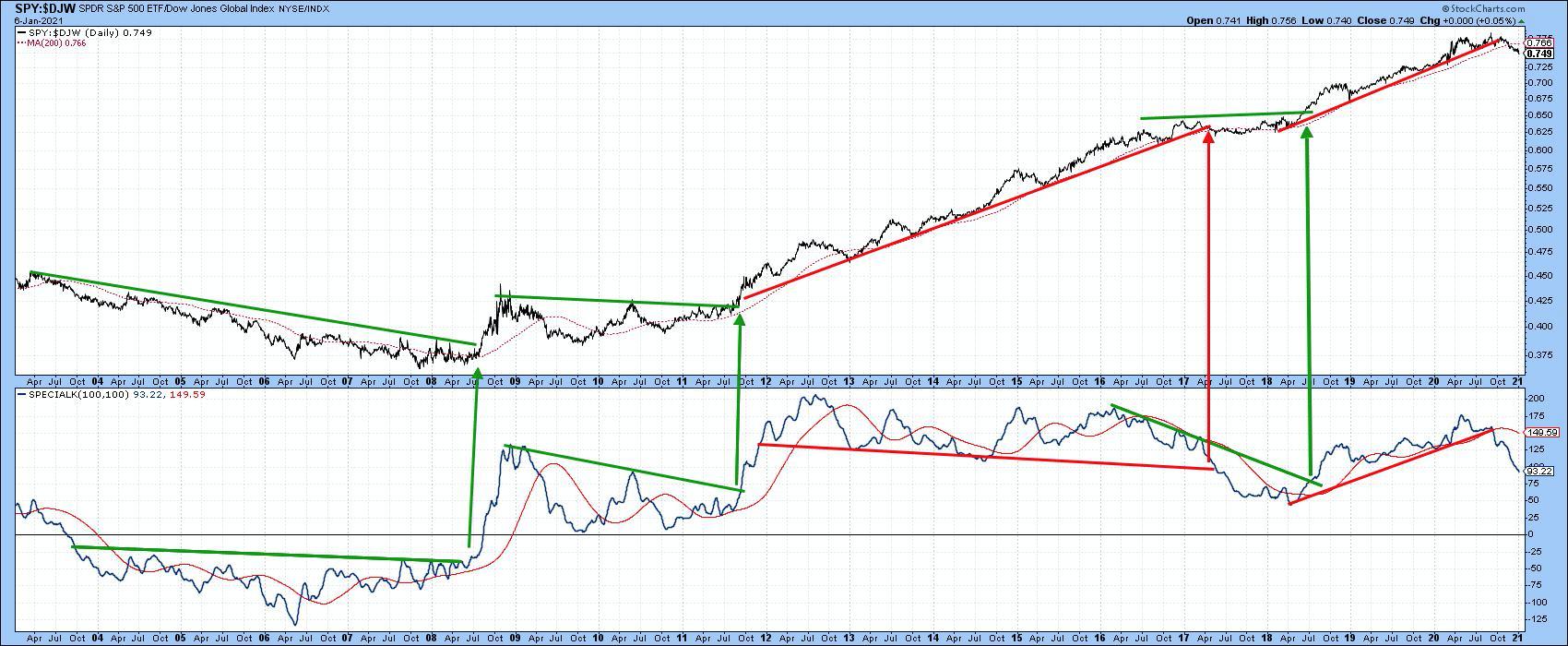 Chart 4 Chart 4
4. Growth versus Value
This relationship looks likely to reverse in favor of value. However, at this time, there is insufficient evidence to prove it. Chart 5 shows that the ratio has just crossed below its 200-day MA. It's certainly not a decisive signal, but needs close monitoring. That's because there has only been one false signal in the last four years. Also, this relationship is right at the neckline of a potential head-and-shoulders top. Since the short-term KST has started to tick over in sympathy with its intermediate counterpart, there is not much margin for error. It's premature to call a top at this point, especially as long-term momentum in the bottom window is still bullish, but it's certainly worth following to see how things turn out going forward. Remember, you can easily update this chart either by clicking on it as more data is available or saving it to a ChartList.
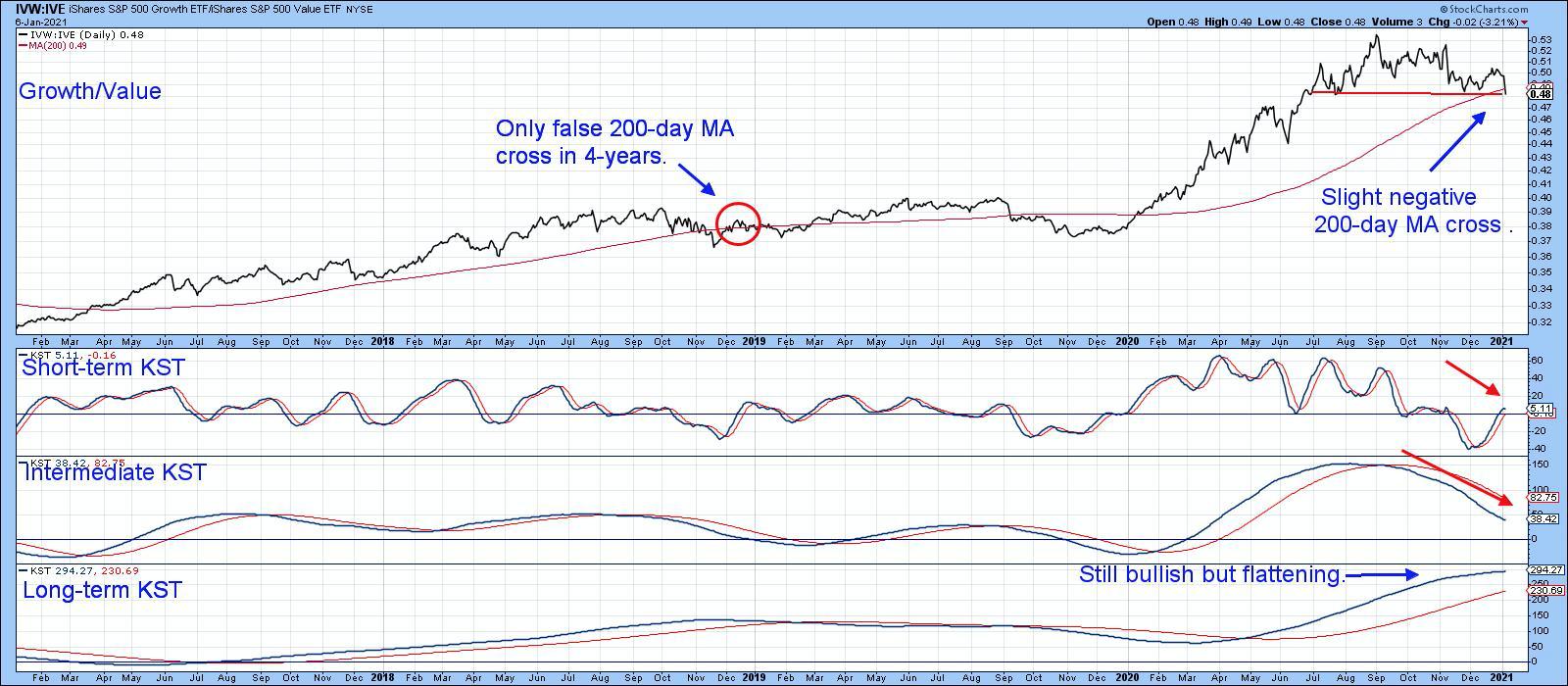 Chart 5 Chart 5
This article was originally published on Wednesday, January 6th at 5:40pm ET in the member-exclusive Martin Pring's Market Roundup blog.
Good luck and good charting,
Martin J. Pring
The views expressed in this article are those of the author and do not necessarily reflect the position or opinion of Pring Turner Capital Group of Walnut Creek or its affiliates.
|
| READ ONLINE → |
|
|
|
| Art's Charts |
| Tracking Trend Signals and Mean-Reversion Setups |
| by Arthur Hill |
Tech-related ETFs are lagging over the last few weeks, but they are still in uptrends overall. This means bullish setups still matter so today we will look at a classic mean-reversion setup in the Software ETF (IGV).
The IGV setup came to light through the ETF Ranking, Trends and Setups table at TrendInvestorPro. This table tracks trend signals, mean-reversion setups, 52-week highs and more for the ETFs in our Core List (currently 118). The image below is a section of this table. The column on the right shows ETFs that became oversold at some point over the last five days, and there were quite a few with the pullback at yearend. The next column quantifies their 52-week range with 100 signaling a 52-week high and 0 a 52-week low.
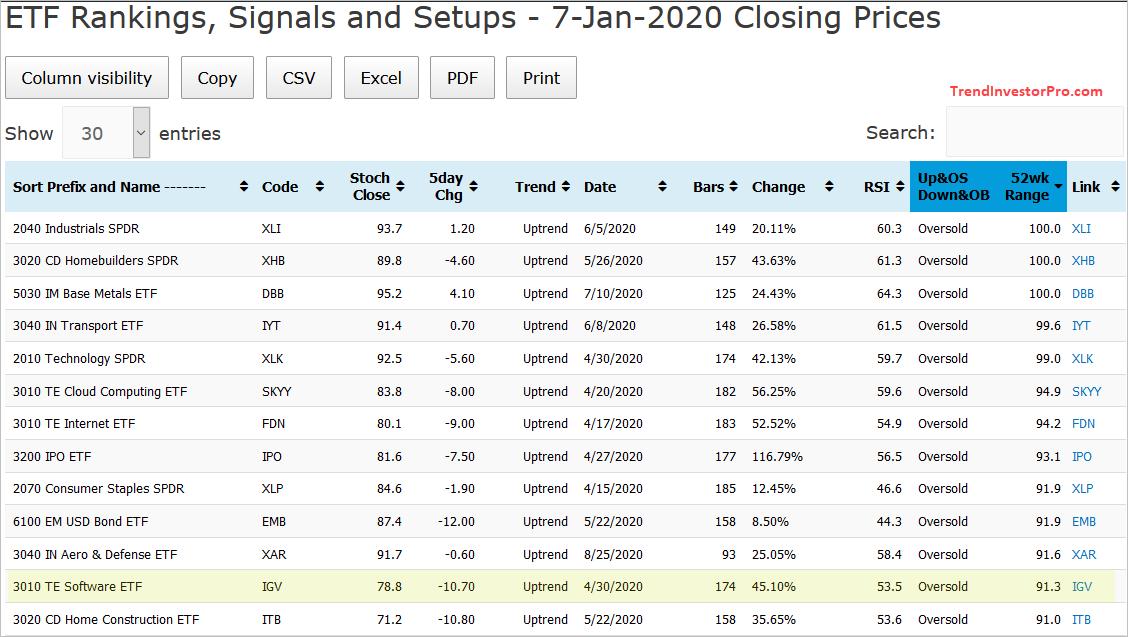
ETFs that are in uptrends and short-term oversold have possible mean-reversion setups and warrant further investigation (chart analysis). Some two dozen ETFs pulled back or consolidated recently and this created an number of mean-reversion opportunities as we started the year.
The chart below shows the Software ETF (IGV) as an example. First, notice that the Full Stochastic (125,5,1) has been bullish since it crossed above 60 in late April (uptrend). Second, IGV broke out in December and hit new highs at yearend. The big trend is clearly up and this means pullbacks are our friends (mean-reversion setups).
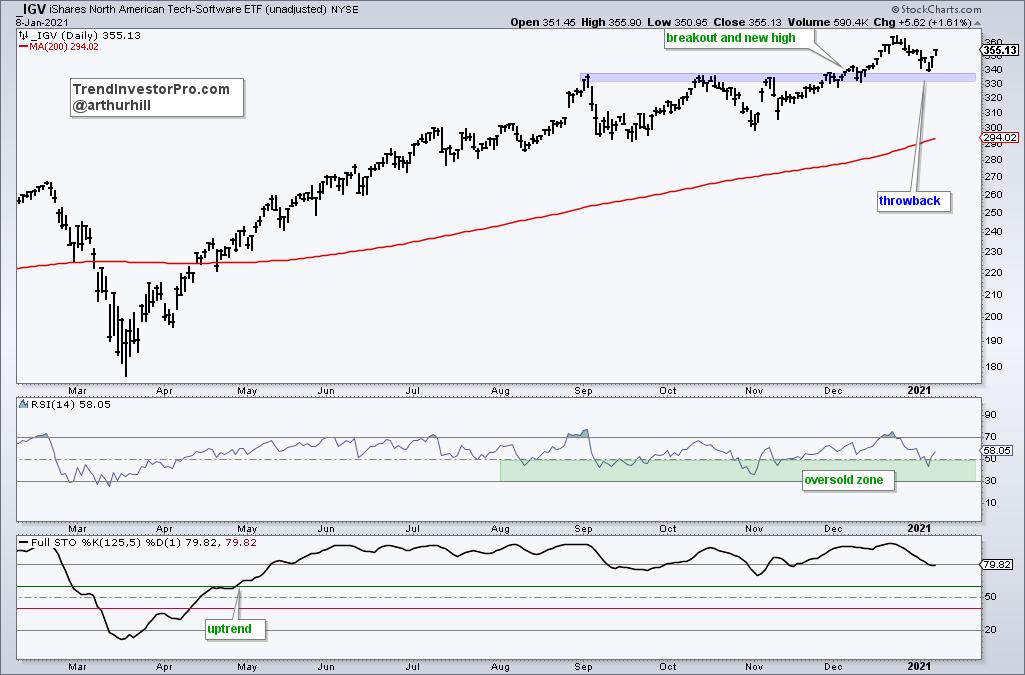
IGV pulled back and RSI(14) dipped into the 30-50 zone on January 6th. This RSI zone denotes a short-term oversold condition of varying degrees. RSI has since moved back above 50 and is no longer oversold. On the price chart, the breakout zone and former resistance area turn first support (blue zone). The decline back to the breakout zone is known as a throwback and the first area to watch for a bounce, which we are getting now.
The ETF Ranking, Trends and Setups table is updated every week at TrendInvestorPro.com. Signals derived from this table and suggested trading strategies are covered with detailed charts in our regular commentaries. Click here to learn more and get immediate access!
--------------------------------------------------
|
| READ ONLINE → |
|
|
|
| The Canadian Technician |
| Is This Industry ETF the Next To Surge? |
| by Greg Schnell |
The radical waves in the economic cycle in 2020 look set to continue into 2021. Elon Musk has outpaced Jeff Bezos as the richest man in the world, which I would have never mapped out as a possibility. The chart of Tesla (TSLA) continues to surge higher. It like betting against Microsoft (MSFT) in the 1990s if you don't believe it can continue. The shorts continue to get squeezed.
But this article isn't about Tesla or electric cars. It is not about the 10% days of Bitcoin, day after day. It's about Gold, which has been unable to mount a serious rally, even in the face of a declining Dollar. While the Federal reserve and central banks everywhere have decided unbridled inflation would be good for a few years, Gold forgot to put together a rally on the news. I would say the table is set for the next breakout. If the breakout does not occur, this is a pretty serious place to watch.
First of all, on the top panel of the chart below, this would be the GLD ETF's third test trying to get through 185 since the August high. There is also an uptrend from the November 30th low that is being tested.
The second panel shows how many stocks are on a buy signal out of the group of major gold miners. Currently, that's just over 55%, with fewer stocks participating on each rally. That is definitely a concern.
The third panel is the Gold Miners ETF (GDX). While the GLD ETF (top panel) keeps returning to 185, the Gold Miners ETF price (third panel) continues to make lower highs. On each rally, the miners get less participation.
The last panel shows the ratio of the Gold Miners compared to the price of Gold. When the price of gold was rallying, the gold miners were as well. As the ratio was trending higher before August, this was helpful. Since then, it has been declining. At this point, this trend is friction for the move up. The good news is that this is the first time the ratio started to make a higher high since the August downtrend started.
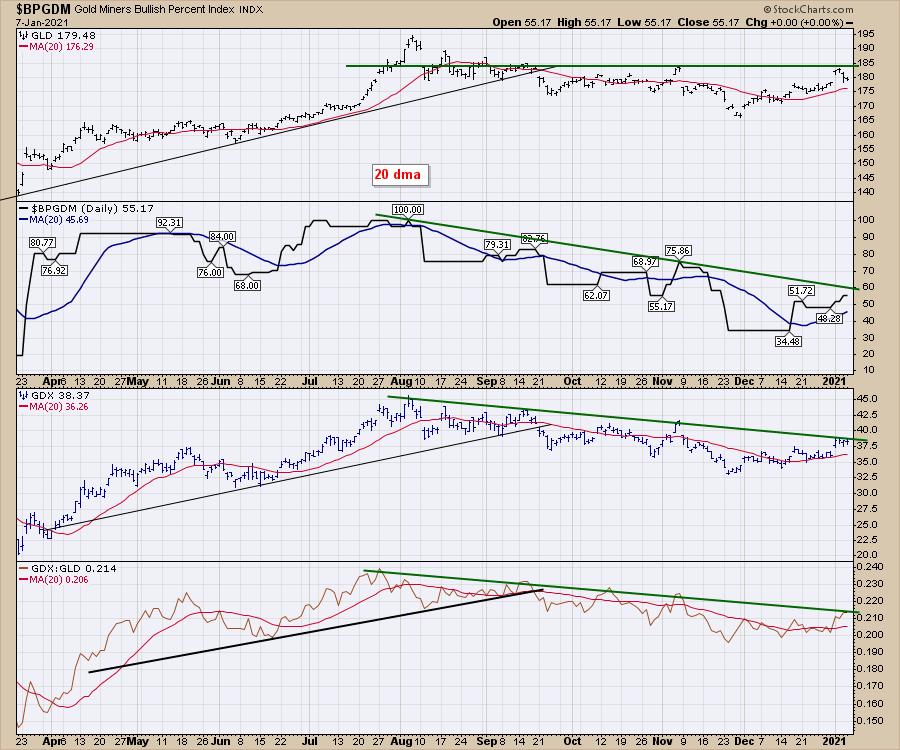
So how do we interpret this chart? As all the charts are up against their trend lines, this is the point of inflection. All four panels have moved back above the 20-day moving average, which is a start. If gold and the miners don't break out here, it is a very important sign. When the bullish precent index (Panel 2) stays below 50%, we are typically in a bigger down trend. That would change this from being the big rally through 2019 and 2020 to restarting another leg down. You don't want to be hanging around in these stocks if that is going to happen. We'll be watching GLD and GDX for more clues of where this is going to go!
It is an important signal for a host of other reasons, but we'll want to see this break through here! For more information on how this resolves, please head over to gregschnell.com and sign up for the articles. Follow this link to be kept abreast of the changing dynamic.
My presentation for StockCharts TV's Reflections 2020 event has been well received. Here is a a direct link to the video. The oil stocks are moving once again, and viewers of this video have a good feel for why this trade continues to work.
StockCharts Reflections 2020 Event
I will be presenting at the Wealth365 Summit in January. I plan on showcasing some more timely strategies for 2021 that will be different than the ones illustrated in this Reflections 2020 presentation. If you want to be one of the first to see this strategy for 2021, follow this link to register for the Wealth365 Summit.
I have been pointing followers into some of the huge movers in the fourth quarter. I had my largest month and largest year ever in a volatile year. Based on the feedback from subscribers of my work, they did too. It was a hard year and investors had a wide range of outcomes.
If you are interested in more of my suggestions, you can check out subscriptions at GregSchnell.com. As I mentioned in starting off this article, the radical waves in the economic cycle in 2020 look set to continue into 2021. Stay tuned for more ideas to help you beat the indexes!
|
| READ ONLINE → |
|
|
|
| ChartWatchers |
| Building a Strong ETF Portfolio to Beat the S&P |
| by John Hopkins |
In my last ChartWatchers article, I mentioned that we had started a new ETF feature of the EarningsBeats.com service. This new feature is meant for those individuals who are interested in putting capital to work in ETFs as part of their trading strategy.
Our first ETF Portfolio consisted of 8 different ETF's that were unveiled to our members on October 19, 2020. The ETFs were meant to be held for 90 days, with the objective being to beat the S&P and with the next batch set to be revealed on January 19. So how has the ETF portfolio performed? As of close of business this past Thursday, the ETF portfolio had risen 14.91%, while the S&P had risen 11% over the same period of time. Nice outperformance!
Every ETF in the portfolio has performed well, with the big star being PBW, which has risen 75% (as can be seen in the chart below).
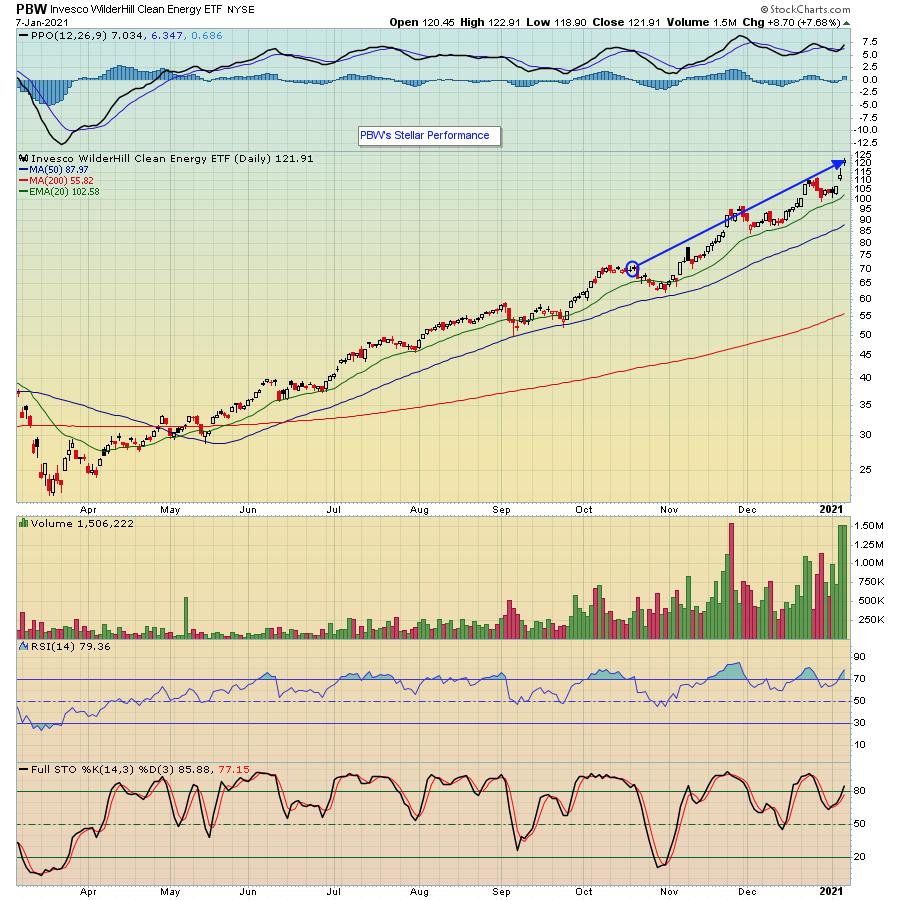
The process of selecting specific ETFs that end up in the portfolio is very time consuming since there are so many ETF's to choose from, and it involves analyzing sector allocations and ensuring that no one ETF is overweight in any one area or stock unknowingly. In other words, we're looking for balance to reduce risk.
While trading ETF's might not seem so "sexy," you can see from the results of our first ETF portfolio that doing your homework can pay handsome dividends. And it all starts with "Knowing What You Own" - what sectors and stocks "lie beneath" the ETF. In fact, our Chief Market Strategist Tom Bowley will be conducting a webinar this Saturday, January 9, at 10:00 am EST, titled "Building an ETF Portfolio the Right Way". This is a FREE webinar open to all members of the EarningsBeats.com community and you can learn more and save a seat by clicking on this link.
Trading individual stocks might put you in a superior position to realize outsized gains. However, trading the right ETF's can prove profitable as well while helping to reduce risk.
At your service,
John Hopkins
EarningsBeats.com
|
| READ ONLINE → |
|
|
|
| MORE ARTICLES → |
|
 Chart 1
Chart 1 Chart 2
Chart 2 Chart 3
Chart 3 Chart 4
Chart 4 Chart 5
Chart 5



















